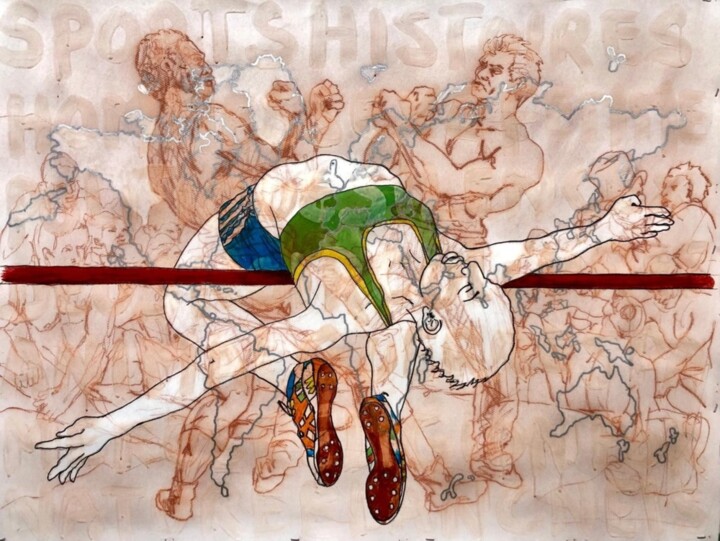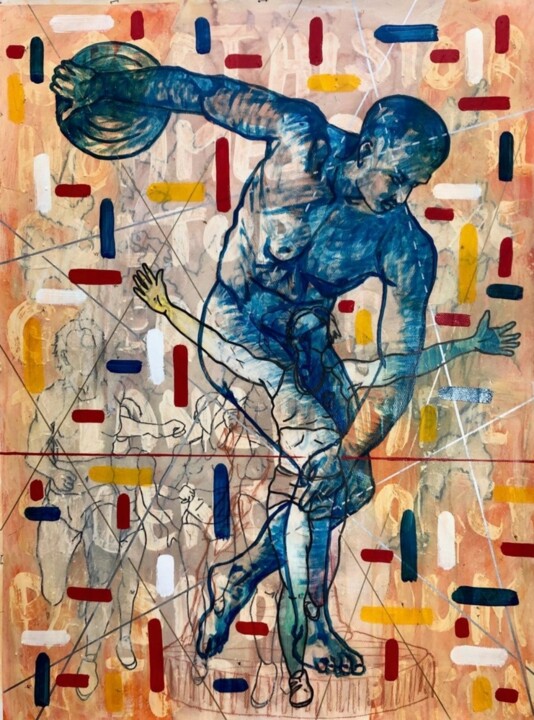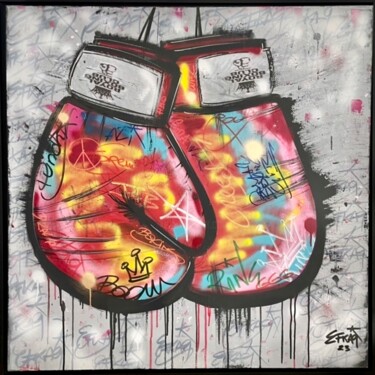 NOBODY IS GOING TO LOVE YOU MORE THAN US (2020) Painting by Anton Terziev
NOBODY IS GOING TO LOVE YOU MORE THAN US (2020) Painting by Anton Terziev
The painting "Nobody is Going to Love You More Than Us" by Anton Terziev captures a moment of pure emotion and triumph. Based on the image of American swimmer Ryan Held, moved after winning gold in the relay at the 2016 Summer Olympics, the painting shows the protagonist with closed eyes and a hand on his heart, conveying a profound sense of emotion and pride for his extraordinary achievement. The gold medal, hanging around his neck, sparkles as a symbol of victory and recognition.
In this context, the artist has enhanced the scene through a technique characterized by dense and vibrant brushstrokes, which give the painting a rich and dynamic texture. The vivid and contrasting colors, such as the red of the athlete's jacket and the bright floral background, create a strong visual impact. The background, adorned with pink and yellow floral patterns, adds an element of delicacy and beauty, contrasting with the emotional intensity of the main subject.
Why did I decide to describe the artistic subject mentioned above? On the occasion of the 2024 Summer Olympics, Artmajeur has decided to create a parallel and shorter event, called, with little imagination, the Artmajeur Olympics. This event celebrates not only sports but also art, highlighting how Olympic disciplines have been depicted in the pictorial medium. Participating in the online art gallery Olympics is extremely simple: just read this article, which will guide you through the most represented Olympic sports on Artmajeur.
Let's return to Anton Terziev's painting to help you understand how, once immersed in this reading, you might feel the thrill of glory on your skin, having effectively participated in a cultural event with extremely competitive themes! Indeed, if you manage to embrace the benefits of Stendhal syndrome, it will be possible to feel like athletes simply by observing the presented artworks. So let's start talking about some popular Olympic disciplines!
 RACE TRACK (2019) Photograph by Jochen Cerny
RACE TRACK (2019) Photograph by Jochen Cerny
 READY... (2022) Photograph by Jochen Cerny
READY... (2022) Photograph by Jochen Cerny
 FINISH LINE (2022) Photography by Jochen Cerny
FINISH LINE (2022) Photography by Jochen Cerny
The Art of Athletics through Photography, Sculpture, and Painting
Let's start with athletics, presenting the first four artists of the Artmajeur Olympics. Subsequently, through other disciplines, we will discover all ten artists, including the previously mentioned Anton Terziev, who has guided us in understanding the objective of this narrative.
Running is the protagonist of an extraordinary series of photographs by Jochen Cerny, which we can interpret as if we were personally attending a sporting event, experiencing each moment as if we were there, among the hot, sweaty, and noisy crowd.
The first image takes us to the empty track, a place of anticipation and potential, which the eager and anxious spectators stare at, waiting for the race to begin, possibly waving their national flag while sipping a beer. "Race Track" captures a blue racing lane through digitally manipulated photography, blending cutting-edge technology with artistic intuition, transforming a simple track into a vibrant and charged scene. The curved white lines mark the paths, creating a visual effect that guides the viewer's eye along the empty surface, suggesting the calm before the action.
As the event approaches, the athletes take their positions. In this context, the second shot, "Ready...", is born, where Cerny presents an athlete ready to start a 110-meter hurdles race. The artist has emphasized the action and concentration of the runner, making the tension palpable. The image conveys a sense of intense preparation and absolute focus, capturing that moment of calm and determination that precedes the starting shot.
Finally, the focus shifts to the entire competition, where four athletes are engaged in a breathtaking race towards the finish line. This is the subject of "Finish Line," a shot full of pure adrenaline and tension, digitally enriched to allude to the materiality of painting. The use of an algorithm allows the harmonious blending of shapes, colors, and textures, creating a work that not only documents but also exalts the beauty and drama of the sport.
On to the next discipline!
 ATHLETISME _ HAIES (2015) Sculpture by André Michel
ATHLETISME _ HAIES (2015) Sculpture by André Michel
 ATHLETISME _ SAUT EN LONGUEUR II (2017) Sculpture by André Michel
ATHLETISME _ SAUT EN LONGUEUR II (2017) Sculpture by André Michel
Athletics, with its dynamic and energetic disciplines, lends itself well to being represented through various artistic forms. Now, hurdles and long jump will be portrayed through sculptural art, embodied from the perspective of André Michel, an artist known for his interest in sports themes. We will analyze two of his most significant works: "Athletisme _ Haies" and "Athletisme _ Saut en longueur II."
Regarding the first sculpture, it captures the moment of the leap in hurdles, rendered through simple minimalist lines forged in brass on wood, with a luminous bronze finish. This technique allows the subject to present all the lightness of its movement, frozen in time as it strives to leave behind the obstacles ahead. The elegance of this dynamism is due to the use of the aforementioned minimalist lines, as well as the varnished or patinated surfaces, which make the composition sober and elegant, capable of highlighting the strength and grace of the athlete.
"Athletisme _ Saut en longueur II," on the other hand, represents the culminating moment of the long jump, again impressed in metal on wood, using synthetic lines of painted, patinated brass with a bronze finish. The athlete is depicted to capture the tension and concentration necessary to execute the movement of the discipline successfully, so much so that the sculpture conveys a sense of lightness and dynamism, emphasized by the essential lines and worked surfaces without foundry.
From a historical-artistic and technical point of view, it is evident that both of André Michel's works share several distinctive stylistic elements, such as the use of minimalist lines that focus attention on the essence of the athletic movement without superfluous distractions, and the choice to avoid the foundry, working directly with metals on wood, giving rise to a direct and artisanal approach to sculpture, which imparts uniqueness and authenticity to each creation.
In terms of content, both sculptures capture crucial moments of athletic activity: overcoming the hurdle in the race and the peak of the long jump. This focus on figures at their maximum effort and concentration expresses all the strength, determination, and grace of the athletes, themes dear to Michel.
 JUMP IN GOLD (2019) Painting by Anatassia Markovskaya
JUMP IN GOLD (2019) Painting by Anatassia Markovskaya
 ESQUIVE (2024) Painting by Nelson Gomes Teixeira
ESQUIVE (2024) Painting by Nelson Gomes Teixeira
We have reached the moment where two artists are being compared by juxtaposing works that depict the same Olympic discipline as well as paintings related to different disciplines. Following this approach, it will be possible to obtain a comprehensive comparison of the artists' work, both of whom are passionate about sports, highlighting themes, techniques, and styles of representation.
"Jump in Gold" by Anatassia Markovskaya is an oil on canvas that is part of her "golden works," a series designed to highlight the modern trend of following a healthy lifestyle as a new religion. The grace and light that characterize this thematic interpretation allude to the inner beauty of the athletes, as well as the elegance of their postures. These postures are inspired by subjects from old Soviet sports photographs, although in the pictorial version, the golden background, similar to that used for painting icons, emphasizes the cult of the athletic body and the almost mythological beauty of the athlete. In summary, "Jump in Gold" depicts the dynamic moment of the jump, capturing the athlete's body in suspension, at the peak of purity and grace of movement.
"Esquive" by Nelson Gomes Teixeira, on the other hand, is a painting created with mixed media on paper, combining acrylic, marker, and pastel, representing a similar moment of athleticism. However, here everything is rendered through the use of fluid lines and vibrant colors, designed to convey the energy of the movement, forming a work that is both detailed and "stylized." By "stylized," we specifically mean all those incomplete and synthetic forms that occupy the background of the painting, alluding to many other Olympic disciplines.
Finally, it becomes evident how Markovskaya has used oil on canvas and a golden background to give a sense of modern sacredness and iconography to her athletic subjects, while Teixeira's rich technique creates a more expressive and immediate work, where movement and action are emphasized through the use of lines and colors.
 GOLDEN GYMNAST (2019) Painting by Anatassia Markovskaya
GOLDEN GYMNAST (2019) Painting by Anatassia Markovskaya
 VICTOIRE (2024) Painting by Nelson Gomes Teixeira
VICTOIRE (2024) Painting by Nelson Gomes Teixeira
Now we will compare different subjects, the peculiarities of which will bring us back to what has already been investigated above, as the artists remain faithful to their stylistic features while varying the discipline represented. Describing now the works, Anatassia Markovskaya's "Golden Gymnast" and Nelson Gomes Teixeira's "Victoire," they depict a gymnast and an athlete at the moment of throwing the discus, respectively. Markovskaya depicts the gymnast in a pose that expresses strength and grace, elevating him to an almost divine status: the golden background and clean lines emphasize the iconic beauty of the movement, giving the work a sense of sacredness and reverence. In contrast, Teixeira captures the energy and dynamism of the discus throw with a vibrant and dynamic composition, using mixed media on paper. His bold lines and intense colors convey the excitement and passion of the sport, while in the background he again stylizes images of other athletes. Both artists thus celebrate the beauty and strength of athletes, but through very different visual languages that can be summarized as follows: Markovskaya with oil on canvas and gold backgrounds, Teixeira with acrylic, marker and pastel on paper.
 GIRL WITH A BALL (2024) Painting by Natalia Yanekina
GIRL WITH A BALL (2024) Painting by Natalia Yanekina
 TRAINING (2024) Painting by Natalia Yanekina
TRAINING (2024) Painting by Natalia Yanekina
 IN A SWIMMING POOL (2024) Painting by Natalia Yanekina
IN A SWIMMING POOL (2024) Painting by Natalia Yanekina
The time has come to talk about aquatic disciplines, such as synchronized swimming and water polo, depicted in a series of three paintings dedicated to female swimmers. These works, created by Lithuanian contemporary painter Natalia Yanekina, explore the grace and beauty of female athletes, capturing intimate and meaningful moments of their sporting activities.
In the first painting, titled "Girl with a Ball," Yanekina depicts a female swimmer with a ball in her hand, probably a water polo player. The athlete is depicted with a concentrated gaze, and the context suggests the environment of a swimming pool, with water and colorful walls visible in the background. The second painting, titled "Training," shows another female swimmer at a specific moment in training: the athlete holds a ball while resting at the edge of the pool, suggesting a break between playing sessions. Finally, the last painting in the series, "In a Swimming Pool," depicts two female swimmers in an aquatic setting. The figures are depicted wearing helmets and goggles, identifying them as synchronized swimming athletes, equipped with a kind of hula hoop.
All these works have two elements in common: the way color is applied, characterized by bold brushstrokes and rich textures, and the artist's interest in investigating different facets of femininity.
 F1. PHANTOM PROJECT (2021) Painting by Anzhelika Palyvoda.
F1. PHANTOM PROJECT (2021) Painting by Anzhelika Palyvoda.
 F3. PHANTOM PROJECT (2021) Painting by Anzhelika Palyvoda
F3. PHANTOM PROJECT (2021) Painting by Anzhelika Palyvoda
The athlete strikes his opponent and wins the match, celebrating with excitement. This is not a single painting, but two that are part of a series by the artist dedicated to consecutive moments of fencing, illustrating the intensity and passion of this sport through vivid and emotional details.
To describe in more detail what was briefly mentioned above, the first painting, titled "F1. Phantom Project," depicts the athlete in full action, with his face still hidden by the black mask, a detail that emphasizes the impact of his movements. It is only thanks to the next painting that the outcome of the thrust can be determined.
In the second painting, the artist captures the subsequent moment of celebration: the athlete, visibly emotional, shouts in victory, while his face, finally visible, expresses a complex range of emotions, including relief, joy, and triumph.
This narrative is rendered through the typical realistic approach of Anzhelika Palyvoda, characterized by particular and close-up framing intended to highlight significant details and moments. It is precisely this choice to focus on specific and intense moments that allows the viewer to immerse themselves completely in the scene, almost feeling the athletes' heavy breathing and the tension in the air, or sharing in their victories with enthusiasm.
 BOXE 6 (2016) Painted by Jérôme Royer
BOXE 6 (2016) Painted by Jérôme Royer
 JANNIK, THE ROVESCIO (2024) Painting by Giancarlo Morandi
JANNIK, THE ROVESCIO (2024) Painting by Giancarlo Morandi
We have reached the end of the Artmajeur Olympics, which will conclude with two works of art that speak of different disciplines but tell complementary stories. Indeed, if the first painting shows us an anonymous and faceless boxing champion, the second sculpture reveals a star from the world of tennis. Who am I talking about? Continue reading to find out...
Starting with the first work, the painting, created with acrylic on linen canvas, depicts the hand of a boxer gripping his boxing gloves, symbolizing strength and determination. In the background, vivid colors and abstract strokes suggest the chaos and energy of a place similar to a ring. The more explicit sculpture in wire, wood, and metals, on the other hand, depicts tennis player Jannik Sinner in the iconic moment of his backhand. The tennis player's face, though stylized, is indeed recognizable and adds a touch of personality and celebration of the athlete.
The work, with its essential and clean lines, captures all the tension and fluidity of the champion's movement. The simplicity of the wire contrasts with the complexity of the athletic gesture, creating a piece that is both dynamic and minimalist.
The Artmajeur Olympics thus conclude with multiple visual tributes to the qualities that make sports so fascinating: determination, the beauty of movement, and the passion of athletes. The works examined remind us that, beyond competition, sports are art in motion, capable of inspiring and moving us in unique and powerful ways.


 Olimpia Gaia Martinelli
Olimpia Gaia Martinelli











